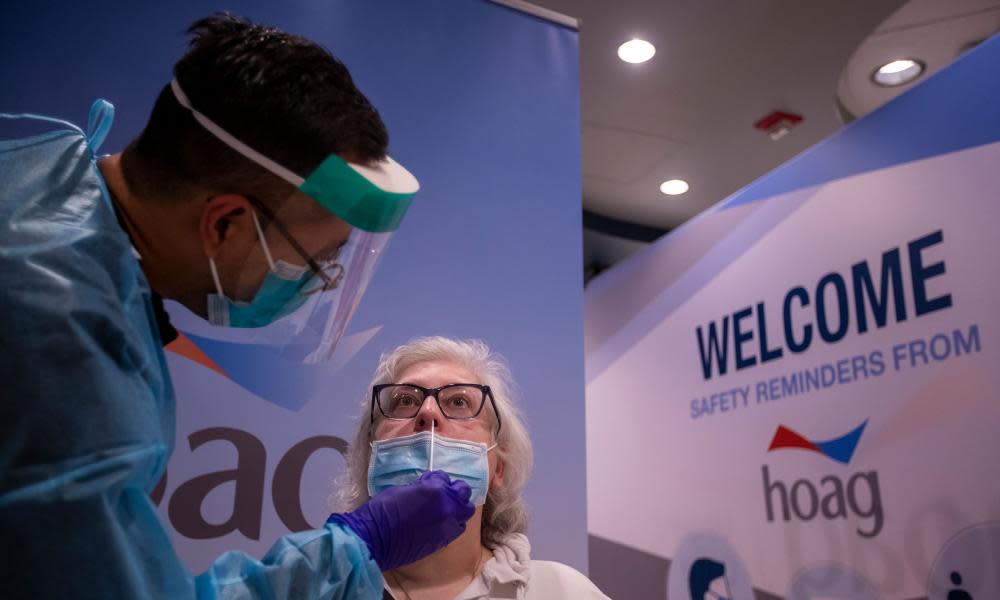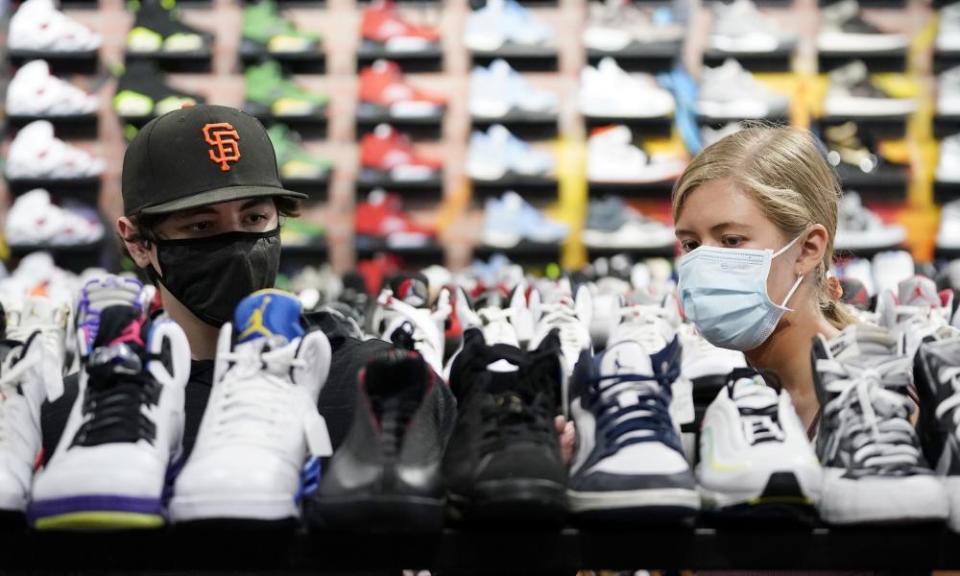As US west braces for omicron surge, leaders take a hands-off approach
- Oops!Something went wrong.Please try again later.

As the highly transmissible Omicron variant began to surge across Colorado this month, Governor Jared Polis adopted a laissez-faire tone. Asked in a radio interview about the possibility of reinstating a statewide mask mandate, he replied that, with Covid vaccines now widely available, getting sick was the “own darn fault” of the unvaccinated.
But health workers at hospitals in parts of Colorado that have been overwhelmed by coronavirus patients in recent weeks say they’re bracing for even worse.
Related: ‘There’s a lot of anxiety’: US grapples with Covid test shortage amid surge
“We are encountering what almost feels like a war zone these days,” said Stephanie Chrisley, an intensive care nurse at Longmont United hospital, about 50 miles north of Denver. She says she is sometimes tasked with caring for twice the number of patients she’d normally be responsible for. The job, she said, has become “morally distressing”.
Hospitals like Chrisley’s are preparing for an even bigger surge, one that will put the most vulnerable residents at risk. And as state leaders across the western US take a hands-off, wait-and-see approach to handling the new variant, experts worry that relying on vaccines alone without additional public health measures won’t be enough.
Vaccination rates across many western states are high, with between 60% and 70% of residents in Oregon, California, Washington, Colorado and New Mexico having been fully vaccinated (though not necessarily boosted). But Omicron, now the dominant variant in the US, appears to be more effective than previous variants at infecting even the doubly vaccinated.
“In this moment, I would not agree with this sort of throwing the hands up and saying this is a pandemic of the unvaccinated,” said Kirsten Bibbins-Domingo, chair of the epidemiology and biostatistics department at the University of California, San Francisco. “The spirit of public health is that we have to think collectively.”
Unlike Colorado, California reinstated its statewide indoor mask mandate last Wednesday. But the state has so far avoided issuing the stay-at-home orders it used to curb infections last December, leaving it up to restaurants and businesses to decide whether or not to scale back service or close. Residents, meanwhile, have been left to individually assess the risks of dining out, going to the gym or meeting with friends and family for the holidays.
In Oregon, officials this week warned that a winter surge would tip already strained hospital systems across the state over the edge and in New Mexico, some hospitals had already been operating under “crisis standards” of care, as patients with Covid-19 and other ailments overwhelm emergency rooms and intensive care units.
In contending with the Omicron variant, one year on from when western states faced a devastating surge and some of the highest case and death counts in the country, Bibbins-Domingo said aggressive vaccination drives and testing, as well as masking rules, will be required to weather the coming months. “Now is not the time to put any of our tools away,” she said. “We need all our tools to keep rising cases of both the Delta and Omicron variants under control.”
Each state has “some things it’s going well and some things it could be doing better”, she added. Colorado could consider reinstating mask mandates, though the state’s push to provide free testing to residents is commendable, Bibbins-Domingo noted.

In California, stronger masking rules are likely to help stem the spread of the virus. But getting rapid at-home tests remains costly and inconvenient, hurting low-income workers at risk of exposure to the virus and who are most in need of frequent testing.
Although a double dose of vaccines seems to protect people from severe illness and hospitalization, workers at restaurants, grocery stores, food processing centers and other jobs where they must interact in close quarters with other people could still carry and transmit the omicron variant to older and immunocompromised relatives, she said.
Relying on vaccines alone also leaves out those who are struggling to access vaccines, or are unable to take them due to age or preexisting conditions.
In many parts of California, Colorado and the broader west, vaccination rates among Latino residents have lagged, a reality that experts say is at least in part due to a lack of outreach and access. Across California, data have also shown lagging vaccination rates among the poorest residents. Even those who want vaccines may face language barriers in scheduling a shot, said Ninez Ponce, a professor of public health at UCLA and the principal investigator of the California Health Interview Survey (CHIS), the largest state health survey in the United States. Others who work multiple jobs while juggling childcare may have trouble finding the time off to get a first dose or booster.
Chrisley, the ICU nurse, said she was disheartened by Polis’ stance that the unvaccinated only have themselves to blame for contracting the virus. “I have a three-year-old who can’t be vaccinated yet. I have friends who are getting treatments for certain illnesses, which prevents them from being able to get vaccinated. There are people who have allergies to certain vaccines,” she said. Just the vaccines aren’t enough to protect everyone, she said. Moreover, especially amid severe medical worker shortages, a surge of unvaccinated Covid-19 patients in hospitals will mean that patients with other illnesses and injuries will be left with nowhere to go for treatment – and everyone will suffer.
Nurses at Chrisley’s hospital recently led a drive to unionize, saying that their workload was unsustainable. “This has always been a hard job, but it has been getting harder,” she said.
At the PIH Health Good Samaritan hospital in Los Angeles, Jennifer Delisle – a medical surgical and orthopedic nurse – said that while the scene this winter is a lot calmer and more in control than it was last year, when LA endured the worst of the pandemic and overflow morgues were set up outside to hold the dead, she is growing uneasy about the months to come. She has seen Angelenos grow laxer about social distancing and masking, forgoing face coverings while holiday shopping, she said. And vaccination rates are stagnating. “People are letting their guard down,” she said.

